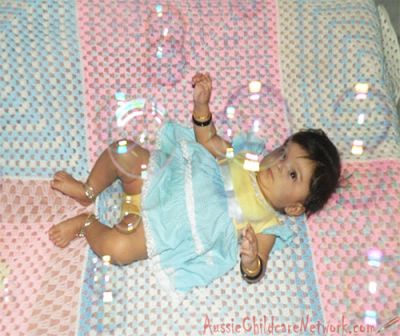Using bubbles to interact with baby.
Materials Needed:
- Bubble Mixture (this is available at your local variety store).
- Bubble wand (normally comes with the bubble mixture).
- DIY – soapy water, wire shaped into a circle.
What to do:
- Lay baby on their back or sit them up using pillows for support.
- Start by blowing bubbles above baby’s head.
- Point to a bubble and get your baby to focus on it. Example “Look at the bubble”.
- As the bubble bursts say “Pop, bubble gone”.
- As you continue blowing bubbles, do so in different directions. Stand up and blow bubbles down onto baby, sit in front of baby and blow bubbles, go on either left or right side of baby to blow bubbles. This will encourage the baby to turn their head to the direction of the bubbles.
Hints and Tips:
- Hold baby’s hands when trying to catch the bubbles.
- Blow bubbles towards baby’s feet so they can feel the bubble burst.
- Use bigger wands for bigger bubbles and smaller wands for smaller bubbles.
- Do not blow bubbles towards baby’s face.
- Party Tip: When playing as a party game, purchase a bubble machine that can be used throughout the day (or) put on some music, have all the babies laying on a mat and begin blowing bubbles towards them.
